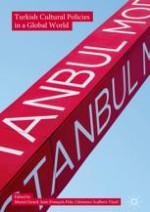2018 | OriginalPaper | Buchkapitel
Istanbul Metropolitan Municipality Art and Vocational Training Courses: A Matrix for Reviving Arts and Handicrafts, Constructing Local Values, and Reworking National Culture
verfasst von : Muriel Girard
Erschienen in: Turkish Cultural Policies in a Global World
Aktivieren Sie unsere intelligente Suche, um passende Fachinhalte oder Patente zu finden.
Wählen Sie Textabschnitte aus um mit Künstlicher Intelligenz passenden Patente zu finden. powered by
Markieren Sie Textabschnitte, um KI-gestützt weitere passende Inhalte zu finden. powered by
